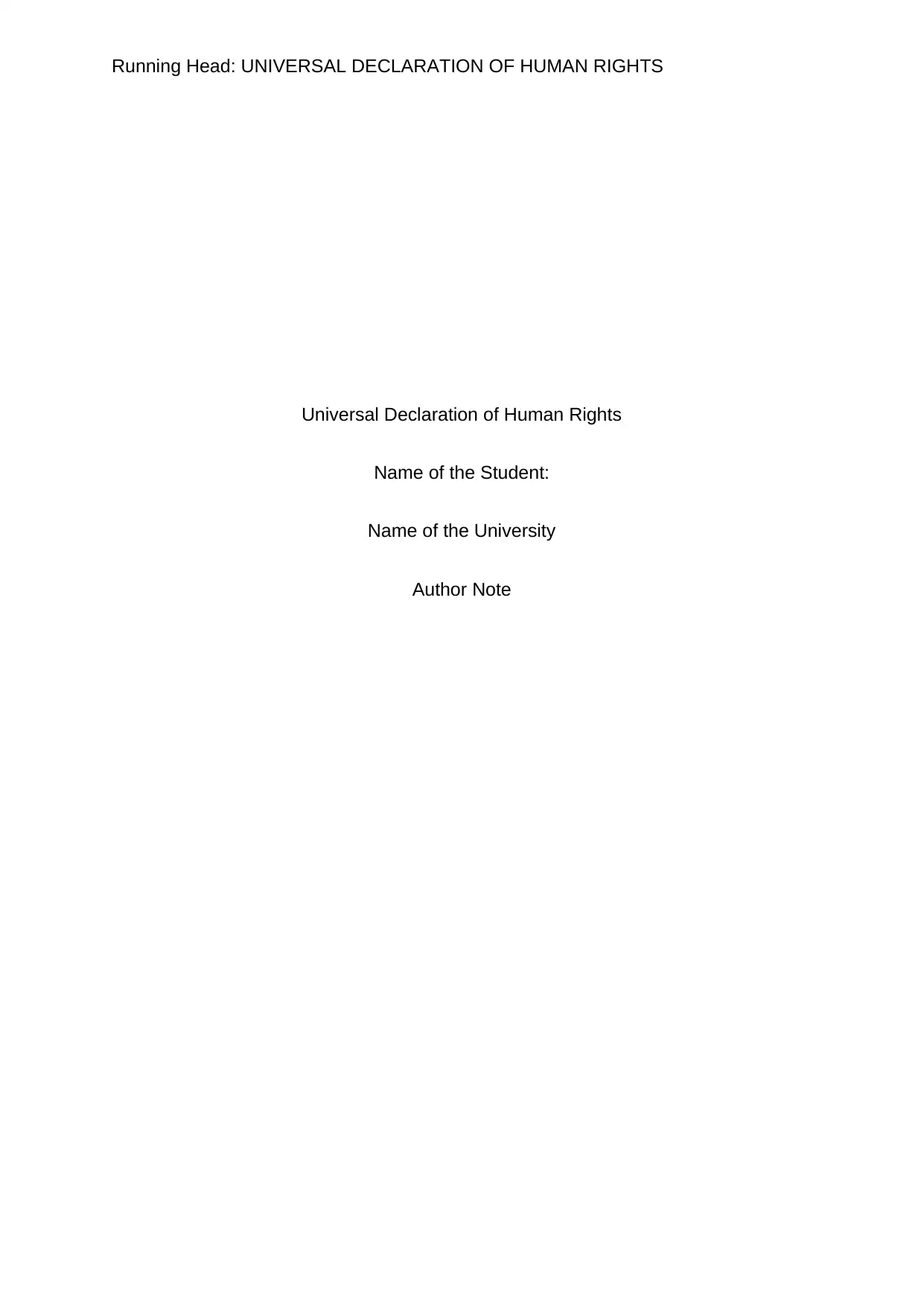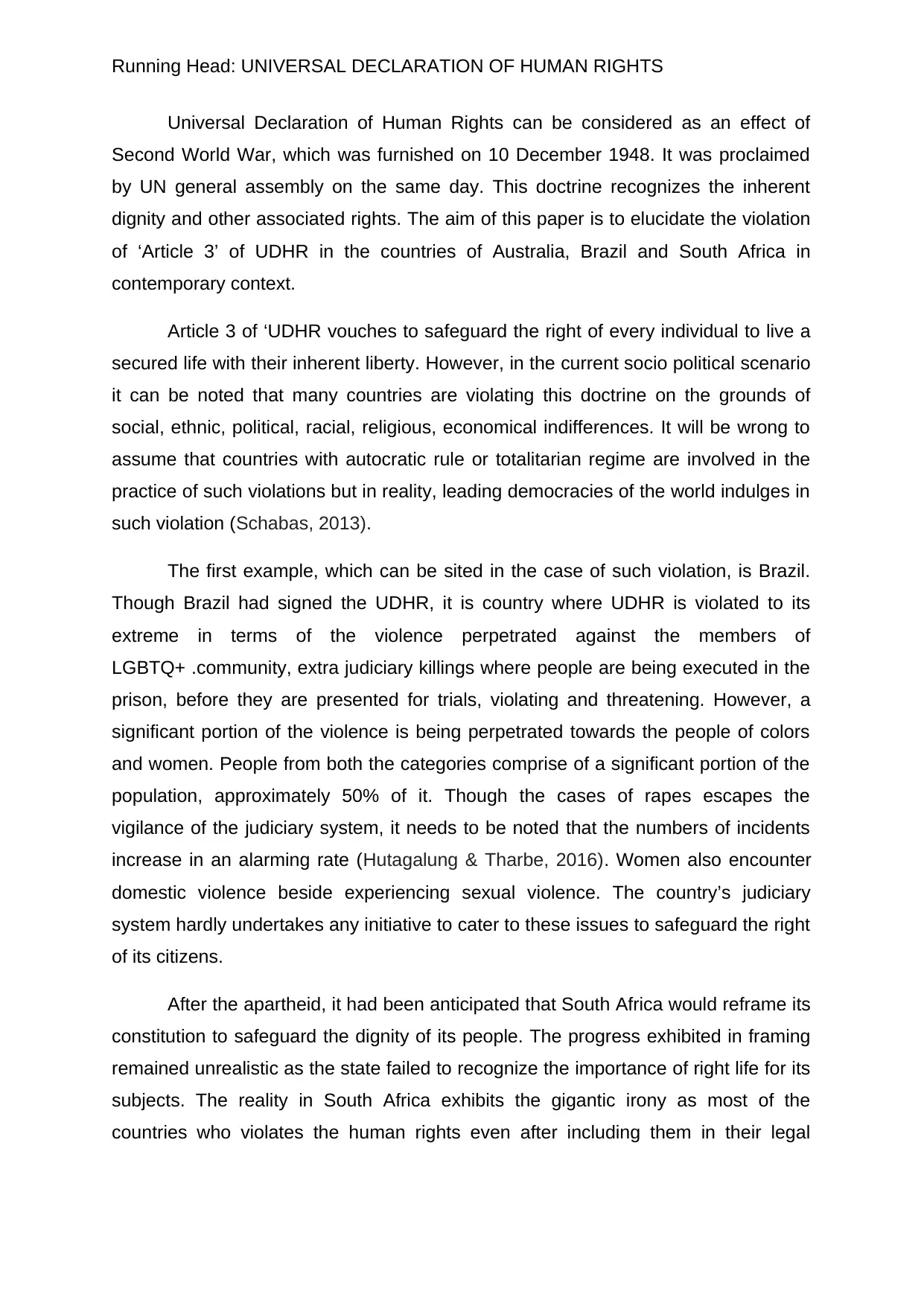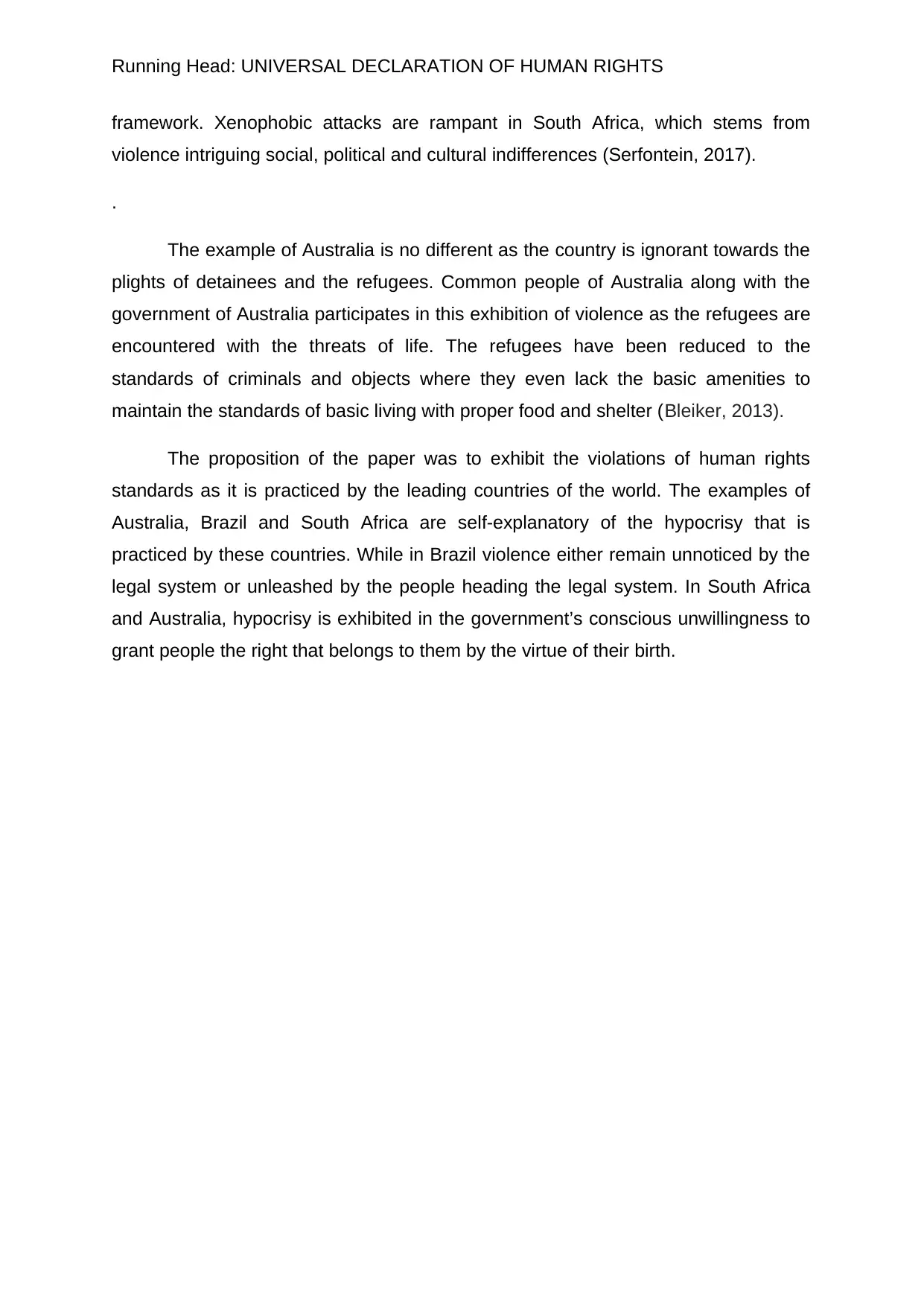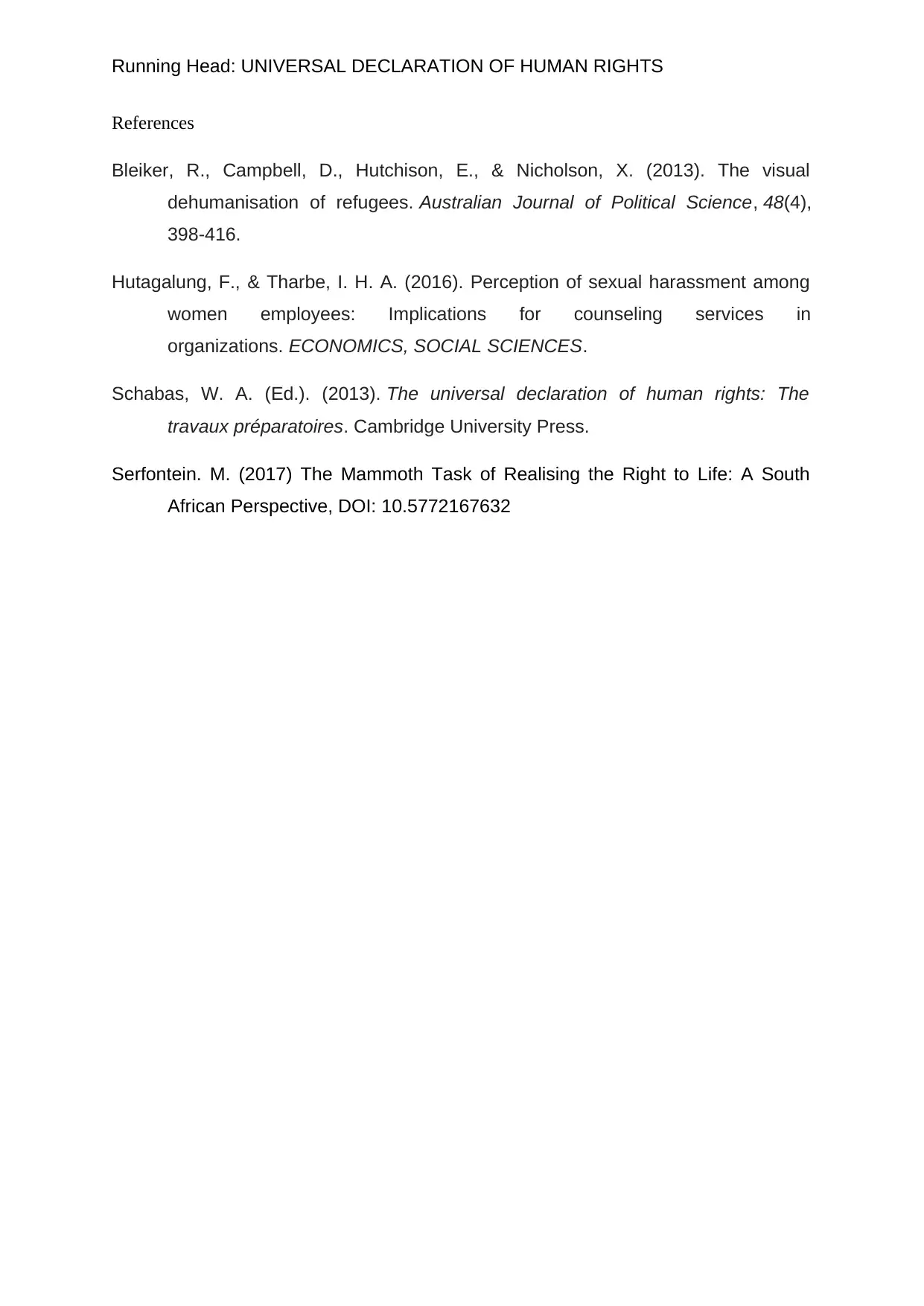FICS001 Essay: Violation of UDHR Article 3 in Three Countries
VerifiedAdded on 2022/09/09
|4
|793
|50
Essay
AI Summary
This essay analyzes the violation of Article 3 of the Universal Declaration of Human Rights (UDHR), which guarantees the right to life and security, in Australia, Brazil, and South Africa. It argues that despite signing the UDHR, these countries exhibit significant human rights violations. In Brazil, th...

Running Head: UNIVERSAL DECLARATION OF HUMAN RIGHTS
Universal Declaration of Human Rights
Name of the Student:
Name of the University
Author Note
Universal Declaration of Human Rights
Name of the Student:
Name of the University
Author Note
Paraphrase This Document
Need a fresh take? Get an instant paraphrase of this document with our AI Paraphraser

Running Head: UNIVERSAL DECLARATION OF HUMAN RIGHTS
Universal Declaration of Human Rights can be considered as an effect of
Second World War, which was furnished on 10 December 1948. It was proclaimed
by UN general assembly on the same day. This doctrine recognizes the inherent
dignity and other associated rights. The aim of this paper is to elucidate the violation
of ‘Article 3’ of UDHR in the countries of Australia, Brazil and South Africa in
contemporary context.
Article 3 of ‘UDHR vouches to safeguard the right of every individual to live a
secured life with their inherent liberty. However, in the current socio political scenario
it can be noted that many countries are violating this doctrine on the grounds of
social, ethnic, political, racial, religious, economical indifferences. It will be wrong to
assume that countries with autocratic rule or totalitarian regime are involved in the
practice of such violations but in reality, leading democracies of the world indulges in
such violation (Schabas, 2013).
The first example, which can be sited in the case of such violation, is Brazil.
Though Brazil had signed the UDHR, it is country where UDHR is violated to its
extreme in terms of the violence perpetrated against the members of
LGBTQ+ .community, extra judiciary killings where people are being executed in the
prison, before they are presented for trials, violating and threatening. However, a
significant portion of the violence is being perpetrated towards the people of colors
and women. People from both the categories comprise of a significant portion of the
population, approximately 50% of it. Though the cases of rapes escapes the
vigilance of the judiciary system, it needs to be noted that the numbers of incidents
increase in an alarming rate (Hutagalung & Tharbe, 2016). Women also encounter
domestic violence beside experiencing sexual violence. The country’s judiciary
system hardly undertakes any initiative to cater to these issues to safeguard the right
of its citizens.
After the apartheid, it had been anticipated that South Africa would reframe its
constitution to safeguard the dignity of its people. The progress exhibited in framing
remained unrealistic as the state failed to recognize the importance of right life for its
subjects. The reality in South Africa exhibits the gigantic irony as most of the
countries who violates the human rights even after including them in their legal
Universal Declaration of Human Rights can be considered as an effect of
Second World War, which was furnished on 10 December 1948. It was proclaimed
by UN general assembly on the same day. This doctrine recognizes the inherent
dignity and other associated rights. The aim of this paper is to elucidate the violation
of ‘Article 3’ of UDHR in the countries of Australia, Brazil and South Africa in
contemporary context.
Article 3 of ‘UDHR vouches to safeguard the right of every individual to live a
secured life with their inherent liberty. However, in the current socio political scenario
it can be noted that many countries are violating this doctrine on the grounds of
social, ethnic, political, racial, religious, economical indifferences. It will be wrong to
assume that countries with autocratic rule or totalitarian regime are involved in the
practice of such violations but in reality, leading democracies of the world indulges in
such violation (Schabas, 2013).
The first example, which can be sited in the case of such violation, is Brazil.
Though Brazil had signed the UDHR, it is country where UDHR is violated to its
extreme in terms of the violence perpetrated against the members of
LGBTQ+ .community, extra judiciary killings where people are being executed in the
prison, before they are presented for trials, violating and threatening. However, a
significant portion of the violence is being perpetrated towards the people of colors
and women. People from both the categories comprise of a significant portion of the
population, approximately 50% of it. Though the cases of rapes escapes the
vigilance of the judiciary system, it needs to be noted that the numbers of incidents
increase in an alarming rate (Hutagalung & Tharbe, 2016). Women also encounter
domestic violence beside experiencing sexual violence. The country’s judiciary
system hardly undertakes any initiative to cater to these issues to safeguard the right
of its citizens.
After the apartheid, it had been anticipated that South Africa would reframe its
constitution to safeguard the dignity of its people. The progress exhibited in framing
remained unrealistic as the state failed to recognize the importance of right life for its
subjects. The reality in South Africa exhibits the gigantic irony as most of the
countries who violates the human rights even after including them in their legal

Running Head: UNIVERSAL DECLARATION OF HUMAN RIGHTS
framework. Xenophobic attacks are rampant in South Africa, which stems from
violence intriguing social, political and cultural indifferences (Serfontein, 2017).
.
The example of Australia is no different as the country is ignorant towards the
plights of detainees and the refugees. Common people of Australia along with the
government of Australia participates in this exhibition of violence as the refugees are
encountered with the threats of life. The refugees have been reduced to the
standards of criminals and objects where they even lack the basic amenities to
maintain the standards of basic living with proper food and shelter (Bleiker, 2013).
The proposition of the paper was to exhibit the violations of human rights
standards as it is practiced by the leading countries of the world. The examples of
Australia, Brazil and South Africa are self-explanatory of the hypocrisy that is
practiced by these countries. While in Brazil violence either remain unnoticed by the
legal system or unleashed by the people heading the legal system. In South Africa
and Australia, hypocrisy is exhibited in the government’s conscious unwillingness to
grant people the right that belongs to them by the virtue of their birth.
framework. Xenophobic attacks are rampant in South Africa, which stems from
violence intriguing social, political and cultural indifferences (Serfontein, 2017).
.
The example of Australia is no different as the country is ignorant towards the
plights of detainees and the refugees. Common people of Australia along with the
government of Australia participates in this exhibition of violence as the refugees are
encountered with the threats of life. The refugees have been reduced to the
standards of criminals and objects where they even lack the basic amenities to
maintain the standards of basic living with proper food and shelter (Bleiker, 2013).
The proposition of the paper was to exhibit the violations of human rights
standards as it is practiced by the leading countries of the world. The examples of
Australia, Brazil and South Africa are self-explanatory of the hypocrisy that is
practiced by these countries. While in Brazil violence either remain unnoticed by the
legal system or unleashed by the people heading the legal system. In South Africa
and Australia, hypocrisy is exhibited in the government’s conscious unwillingness to
grant people the right that belongs to them by the virtue of their birth.
⊘ This is a preview!⊘
Do you want full access?
Subscribe today to unlock all pages.

Trusted by 1+ million students worldwide

Running Head: UNIVERSAL DECLARATION OF HUMAN RIGHTS
References
Bleiker, R., Campbell, D., Hutchison, E., & Nicholson, X. (2013). The visual
dehumanisation of refugees. Australian Journal of Political Science, 48(4),
398-416.
Hutagalung, F., & Tharbe, I. H. A. (2016). Perception of sexual harassment among
women employees: Implications for counseling services in
organizations. ECONOMICS, SOCIAL SCIENCES.
Schabas, W. A. (Ed.). (2013). The universal declaration of human rights: The
travaux préparatoires. Cambridge University Press.
Serfontein. M. (2017) The Mammoth Task of Realising the Right to Life: A South
African Perspective, DOI: 10.5772167632
References
Bleiker, R., Campbell, D., Hutchison, E., & Nicholson, X. (2013). The visual
dehumanisation of refugees. Australian Journal of Political Science, 48(4),
398-416.
Hutagalung, F., & Tharbe, I. H. A. (2016). Perception of sexual harassment among
women employees: Implications for counseling services in
organizations. ECONOMICS, SOCIAL SCIENCES.
Schabas, W. A. (Ed.). (2013). The universal declaration of human rights: The
travaux préparatoires. Cambridge University Press.
Serfontein. M. (2017) The Mammoth Task of Realising the Right to Life: A South
African Perspective, DOI: 10.5772167632
1 out of 4
Your All-in-One AI-Powered Toolkit for Academic Success.
+13062052269
info@desklib.com
Available 24*7 on WhatsApp / Email
![[object Object]](/_next/static/media/star-bottom.7253800d.svg)
Unlock your academic potential
© 2024 | Zucol Services PVT LTD | All rights reserved.

